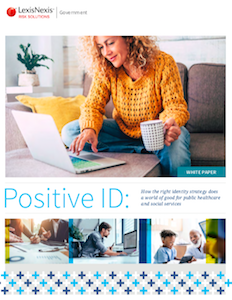- Sponsored
- Modernization
How developing a strong identity strategy can better serve citizens

As the COVID-19 pandemic continues, public sector agencies that offer assistance and support programs to citizens should use identity verification to streamline, improve and proactively deliver services, says a recent white paper.
With an estimated 1 in 5 U.S. residents served by a government program, and more than 175 million citizens receiving some form of federal or state public assistance, public sector agencies need identity management that certifies citizens are who they say they are.

Read the full report.
And as a result of the pandemic, large-scale unemployment demands also means agencies will be serving even more people over the coming months.
In a white paper, LexisNexis Risk Solutions encourages public sector agencies to keep vulnerable citizens in mind when considering modern identity tools. A strong identity management strategy can proactively offer public healthcare and social service programs to those in need, while also cutting down on instances of fraud.
The challenges facing agencies are vast. Whether it’s resource limitations, vulnerability to data breaches, inconsistent data entry on applications and rapidly growing caseloads. Agencies need a new approach to identity management that centers around proofing and verification, according to the white paper.
To combat these challenges, agencies need to:
- Leverage their network of supporting intelligence to assess all aspects of a transaction
- Provide a single physical and digital view of identities
- Enable real-time intelligence
- Capitalize on behind-the-scenes verification mechanisms to minimize friction
- Use more accurate up-front identity verification to identify fraud and minimize future investigations or losses
- Address the needs of diverse populations
These steps are key, especially as states like Washington grapple with unemployment fraud scams from ransomware attackers. By combining commonly used identity elements — like a passport and driver’s license — along with alternative methods, agencies can analyze and assess the risk of fraud.
In addition, the use of identity proofing and authentication can speed up the application process, reduce delays, optimize workflows, reduce false positives and control costs.
Through the use of solutions like LexisNexis Risk Solutions Identity Assessment & Assurance, agencies have access to more than 10,000 additional data sources to help in the validation process, a team of cross-trained analysts to handle investigations of potential fraud, as well as government-specific databases that share insight from across agencies.
These solutions are also specifically built for the public sector and designed for the way citizens interact with public sector agencies.
“[Assistance] programs have slashed the poverty rate in America by nearly half since 1967,” the white paper reads. “Recent events have shown how quickly things can change, and how important these programs can be. This is how identity management should begin, because this is the big picture. You are in the business of human well-being.”
To learn more, read LexisNexis Risk Solutions’ white paper: Positive ID: How the right identity strategy does a world of good for public healthcare and social services.
This article was produced by FedScoop and StateScoop for, and sponsored by, LexisNexis Risk Solutions.






